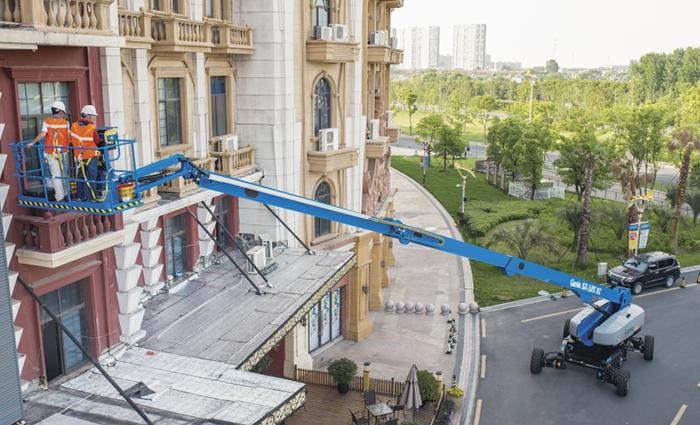Aerial lifts are essential tools for reaching high areas in construction, maintenance, and other industries. However, renting an aerial lift can be a significant investment, and it’s important to make the most of your rental period. To ensure you get the most efficiency and safety out of your rental, it’s crucial to choose the right aerial lift rental companies, aerial lift rental near me, aerial lift equipment rental, towable aerial lift rental, or aerial lift rental home depot, and follow some best practices. In this article, we will provide tips and best practices for maximizing efficiency and safety when renting aerial lifts.
Expert Tips
1. Choose the Right Aerial Lift for Your Needs
The first step in maximizing your aerial lift rental is choosing the right lift for your project. Aerial lifts come in different types, including boom lifts, scissor lifts, and personnel lifts, each with unique capabilities and limitations. Consider the height and reach you need, the weight capacity required, and the terrain or obstacles you’ll encounter when selecting your lift.
2. Inspect the Aerial Lift Before Use
Before operating the aerial lift, inspect it for any damage or malfunctions. Look for leaks, cracks, worn-out parts, or loose bolts. Check the tires, brakes, and steering system. Verify that all safety features, including guardrails, harnesses, and emergency stops, are in good working condition. If you notice any issues, report them to the rental company and do not use the lift until it’s repaired.
3. Train and Certify Your Operators
Only trained and certified operators should operate aerial lifts. Ensure that your operators are properly trained and certified to operate the specific type of lift you’re renting. They should understand the controls, safety features, and emergency procedures. Proper training can prevent accidents and injuries and ensure the efficient use of the aerial lift.
4. Plan Your Work and Route
Before using the aerial lift, plan your work and route carefully. Identify the areas you need to access, the obstacles you need to avoid, and the potential hazards you need to mitigate. Plan your route to minimize the need to move the lift around, as frequent repositioning can waste time and fuel. Make sure you have a clear line of sight and communicate with your team members and ground personnel to ensure everyone is aware of your movements.
5. Use Personal Protective Equipment (PPE)
Personal protective equipment (PPE) is essential for working at height. Make sure that all operators and workers using the aerial lift wear the appropriate PPE, such as hard hats, safety glasses, high-visibility vests, and non-slip footwear. If the job requires working near electrical hazards, ensure that the PPE is rated for electrical protection.
6. Follow Safe Operating Procedures
Follow safe operating procedures when using the aerial lift. This includes properly positioning the lift, setting the brakes, and using the controls to move the lift. Always keep both hands on the controls and avoid using your phone or other distractions. Never exceed the weight capacity of the lift, and avoid sudden movements or overreaching, which can cause the lift to tip over. If you need to move the lift, do so slowly and cautiously.
7. Be Prepared for Emergencies
In case of an emergency, make sure you’re prepared. Have a first-aid kit and a fire extinguisher on the aerial lift. Train operators and workers on emergency procedures, such as what to do in case of a power outage, a hydraulic failure, or a person stuck in the lift. Have a communication plan in place to alert emergency services if needed.
8. Maintain and Clean the Aerial Lift
Proper maintenance and cleaning can extend the life of the aerial lift and prevent breakdowns. Follow the manufacturer’s maintenance schedule, including checking and changing the fluids, inspecting the brakes, and lubricating the moving parts. Clean the lift regularly to remove dust, dirt, and debris that can damage the lift or cause accidents.
9. Return the Aerial Lift in Good Condition
After completing your project, return the aerial lift in good condition. Clean the lift and remove any debris, tools, or materials that may have accumulated during the rental period. Check for any damages or malfunctions that may have occurred during your use and report them to the rental company. Follow the rental company’s instructions for returning the lift, including fueling and charging requirements.
10. Consider Long-Term Rental Options
If you have ongoing projects that require aerial lifts, consider long-term rental options. Renting for longer periods can save you money and provide you with the flexibility to use the lift as needed. Some rental companies offer rental-purchase options, which allow you to rent the lift and then purchase it at the end of the rental period.
Conclusion
Aerial lifts are essential tools for reaching high areas in construction, maintenance, and other industries. However, aerial lift rental can be a significant investment, and it’s important to make the most of your rental period. To ensure you get the most efficiency and safety out of your rental, it’s important to choose the right aerial lift rental companies, aerial lift rental near me, aerial lift equipment rental, towable aerial lift rental, or aerial lift rental home depot, and follow some best practices.
By choosing the right lift, inspecting it before use, training and certifying your operators, planning your work and route, using PPE, following safe operating procedures, being prepared for emergencies, maintaining and cleaning the lift, returning it in good condition, and considering long-term rental options, you can maximize your aerial lift rental and ensure a successful project. Always remember to prioritize safety in all your aerial lift operations. Get in touch with the team at Xpress Aerial Lift Rentals today.


